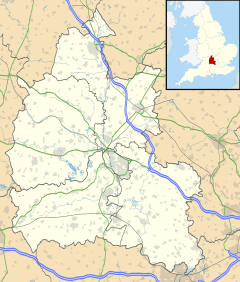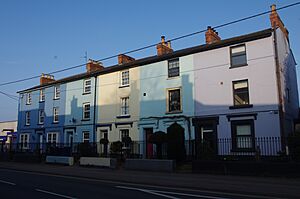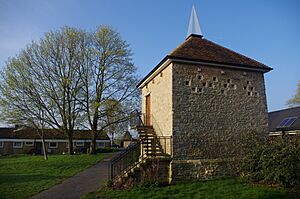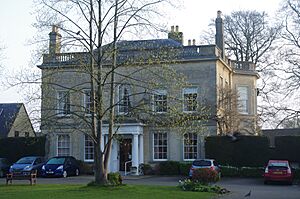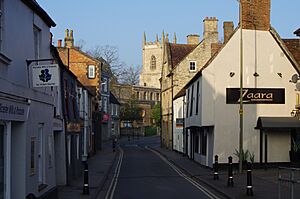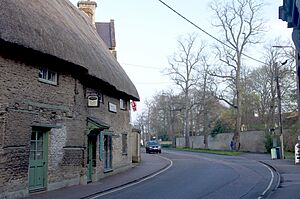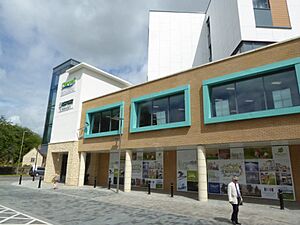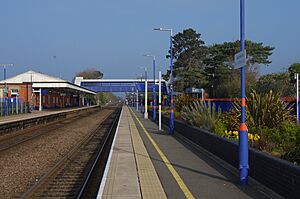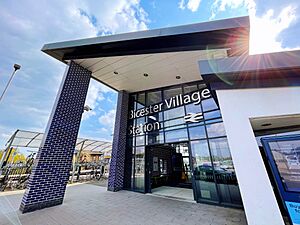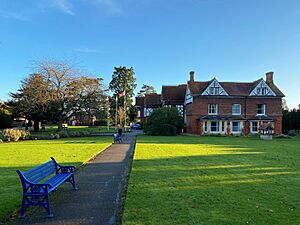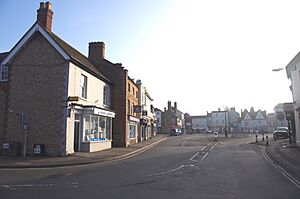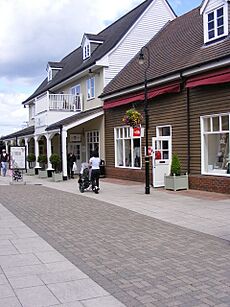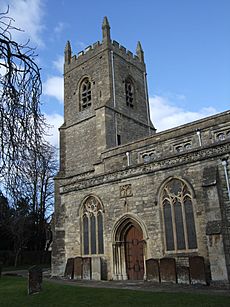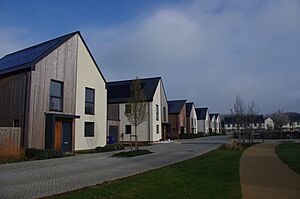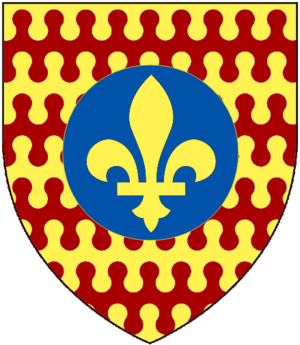Bicester facts for kids
Quick facts for kids Bicester |
|
|---|---|
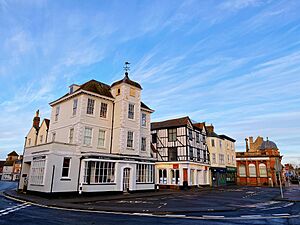 Market Square, Bicester |
|
| Area | 8.58 km2 (3.31 sq mi) |
| Population | 37,020 (2021 census) |
| • Density | 4,315/km2 (11,180/sq mi) |
| OS grid reference | SP5822 |
| Civil parish |
|
| District |
|
| Shire county | |
| Region | |
| Country | England |
| Sovereign state | United Kingdom |
| Post town | BICESTER |
| Postcode district | OX25–27 |
| Dialling code | 01869 |
| Police | Thames Valley |
| Fire | Oxfordshire |
| Ambulance | South Central |
| EU Parliament | South East England |
| UK Parliament |
|
Bicester (![]() i/ˈbɪstər/ BIST-ər) is a lively market town and civil parish in Oxfordshire, England. It is about 11 miles (18 km) northwest of Oxford. Many tourists visit Bicester for its famous Bicester Village shopping centre. The historical town centre has a local market and many unique shops and restaurants. Bicester also has its own town council and a mayor.
i/ˈbɪstər/ BIST-ər) is a lively market town and civil parish in Oxfordshire, England. It is about 11 miles (18 km) northwest of Oxford. Many tourists visit Bicester for its famous Bicester Village shopping centre. The historical town centre has a local market and many unique shops and restaurants. Bicester also has its own town council and a mayor.
The town has always had great transport links. Two old Roman roads crossed here. Today, you can travel by train directly to Oxford, London, and Birmingham. A new railway, East West Rail, is being built to connect Bicester to Milton Keynes and Cambridge. The A41 road also runs through the town, linking it to other major roads.
Bicester grew a lot in the 20th century because of its military importance. RAF Bicester, an air force base, was set up in 1917. A large supply depot was built in 1942 to help with World War II. These military sites led to the town's growth after the war. RAF Bicester is now a heritage centre for civilian use.
Bicester is one of the fastest-growing towns in Oxfordshire. It is part of the Oxford–Cambridge Arc, an area planned for growth. The town has expanded quickly and more homes are planned. In 2014, the government called Bicester a "Garden Town." This means new homes are built to be high-quality and good for the environment. Examples include the North West Bicester eco-town and the self-built homes at Graven Hill.
Contents
- What's in a Name?
- Bicester's Past
- Bicester's Location
- Town Buildings
- Getting Around Bicester
- How Bicester is Governed
- Schools in Bicester
- Local Media
- Sports and Fun
- Shopping in Bicester
- Churches in Bicester
- Future Plans for Bicester
- Twin Towns
- Famous People from Bicester
- Bicester's Coat of Arms
- See also
What's in a Name?
There are a few ideas about where the name Bicester comes from. One idea is that it means "Fort of the Warriors," from a name like Beorna. Another thought is that it comes from the Latin "Bi-cester," meaning "two forts." This makes sense because Alchester, an old Roman fort, is about 2 miles (3 km) southwest. Also, Chesterton village is on Akeman Street, a Roman road, about 1 mile (1.6 km) northwest of Alchester.
People have lived in Bicester since the mid-600s. The town's name has changed over time. Some old names include Berncestre and Bissiter. In 1610, a map showed four different spellings. One historian even found 45 different ways the name was spelled in old documents!
Bicester's Past
Early Settlements
Bicester is located near where two Roman roads met. One road, Akeman Street, went east to west between St Albans and Cirencester. The other went north to south between Dorchester and Towcester. This north-south road is now under Queen's Avenue. A Roman fort called Alchester is about 2 miles (3 km) southwest of Bicester.
In the 6th century, the West Saxons started a settlement here. It was a good spot because of these old roads.
Church History
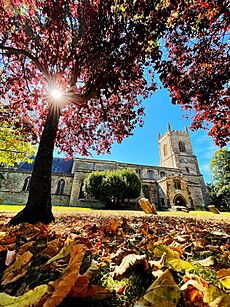
St. Edburg’s Church in Bicester was likely founded around the mid-600s. This was after St. Birinus helped convert Cynegils, the King of Wessex. The church was probably made of timber at first. It served the growing Saxon villages on both sides of the River Bure. It was also a centre for spreading Christianity in the area.
The first time Bicester is mentioned in writing is in the Domesday Book of 1086. It was called Berencestra then. Its two main areas, Bicester and Wretchwick, were owned by Robert D'Oyly. He was the one who built Oxford Castle. The town grew as two settlements on opposite banks of the River Bure.
By the late 1200s, Bicester was an important church centre for 33 churches. Parts of an Augustinian priory (a type of monastery) founded around 1182 still stand in the town centre. The church was rebuilt in stone sometime in the 1100s. You can still see parts of the old walls and arches from that time.
The Augustinian Priory was started by Gilbert Basset around 1183. It was given land and buildings nearby. This included land at Kirtlington, Wretchwick, Stratton Audley, Gravenhill, and Arncott. The priory also owned a mill and farms.
In the 14th century, the church was made bigger with a new north aisle. Later, in the 15th century, the upper walls of the main church area were raised. This added more windows and light. The large tower at the west end of the church was built in three stages. It would have taken many years to finish.
The priory church itself was built around 1200. It was made larger around 1300 for the tomb of St. Eadburh. The priory had a walled area south of the church. The gatehouse was where 'Chapter and Verse' Guesthouse is now. The old dovecote and houses in Old Place Yard are inside the priory's central area.
Early agreements helped Bicester grow as a trading place. A market and fair were set up by the mid-1200s. By this time, two more areas were mentioned: Bury End (later Market End) and Nuns Place (later King's End).
Military Connections
Bicester has a long history with the military. Some people think Alchester, the Roman fort, was like a Roman army base. During the English Civil War (1642–49), Bicester was a base for the Parliament's army.
When wars with France started in 1793, a local leader named John Coker formed a group to protect property. This group provided local militia (volunteer soldiers) for the army. When Oxford University formed its own regiment in 1798, John Coker became its leader.
Bicester's militia had 60 private soldiers and officers. They were very well trained. Their only recorded action was a celebration in 1806, where they fired their guns in a salute.
During the First World War, an airfield was built north of Bicester for the Royal Flying Corps. This became a Royal Air Force (RAF) station, now called Bicester Airfield. It is home to a gliding club. RAF Bicester is known as one of the best-preserved bomber airfields from before 1939.
The Ministry of Defence (MoD)'s largest supply depot, MoD Bicester, is just outside the town. This depot even has its own railway system, the Bicester Military Railway.
Later Town Life
In 1724, a fire destroyed buildings on one side of Water Lane. A Nonconformist church was built there in 1728. At the other end of Water Lane, there were problems with pollution from animal waste.
Edward Hemins ran a bell-making business in Bicester from 1728. He made at least 19 church bells that are still around today.
The King's End area of Bicester had fewer people and less business than Market End. The Coker family, who owned the land, lived in the manor house from 1584. The house was rebuilt in the early 1700s. The park around it was made bigger, which meant a Roman road had to be moved. This sent traffic through King's End and Market Square.
Market End became the main business area. Inns, shops, and nice houses were built around the market square. Away from the market, Sheep Street was considered a good area. But its northern end, Crockwell, had very poor, crowded housing.
By 1800, the Causeway had many buildings on both sides. People used the nearby streams for drainage, and many houses had toilets that emptied directly into the water. This caused pollution problems.
Before the early 1800s, the road from the market to King's End went through a shallow part of the Bure brook. Later, the Causeway became a focus for building as rubbish was used to create platforms for new homes.
Bicester's Location
Bicester is in northern Oxfordshire, about 11 miles (18 km) east-northeast of Oxford. It is close to the borders of Buckinghamshire and Northamptonshire.
 |
Banbury, Royal Leamington Spa | Brackley, Northampton | Buckingham, Milton Keynes, Bletchley |  |
| Chipping Norton, Cheltenham | Aylesbury, Leighton Buzzard | |||
| Woodstock | Kidlington, Oxford | Thame |
Town Areas
Bicester has five main voting areas: North, East, South, West, and Town. The different parts of Bicester include:
- Highfield
- Woodfield
- King's End
- Bure Park
- Glory Farm
- Southwold
- Langford Village
- Kingsmere (new housing development)
- Elmsbrook (new housing development, eco-town)
- Graven Hill (new housing development)
- New Langford
Weather
Bicester has an oceanic climate, which is typical for most of the United Kingdom. This means it has mild winters and cool summers.
| Climate data for Bicester | |||||||||||||
|---|---|---|---|---|---|---|---|---|---|---|---|---|---|
| Month | Jan | Feb | Mar | Apr | May | Jun | Jul | Aug | Sep | Oct | Nov | Dec | Year |
| Mean daily maximum °C (°F) | 7 (45) |
7 (45) |
10 (50) |
13 (55) |
16 (61) |
20 (68) |
22 (72) |
21 (70) |
18 (64) |
14 (57) |
10 (50) |
7 (45) |
13 (55) |
| Mean daily minimum °C (°F) | 1 (34) |
1 (34) |
3 (37) |
4 (39) |
7 (45) |
10 (50) |
12 (54) |
12 (54) |
10 (50) |
7 (45) |
4 (39) |
2 (36) |
6 (43) |
| Average rainfall mm (inches) | 56.1 (2.21) |
39.4 (1.55) |
49.6 (1.95) |
42.3 (1.67) |
59.0 (2.32) |
45.1 (1.78) |
52.3 (2.06) |
57.7 (2.27) |
52.1 (2.05) |
62.5 (2.46) |
65.3 (2.57) |
62.5 (2.46) |
643.9 (25.35) |
| Average snowy days | 5 | 5 | 3 | 1 | 0 | 0 | 0 | 0 | 0 | 0 | 0 | 2 | 16 |
Town Buildings
The traditional buildings in Bicester show styles from both the Cotswold area and the Thames Valley. The oldest buildings still standing are the medieval St Edburg church, the vicarage from 1500, and two houses built after the Dissolution of the Monasteries. These houses used materials from the old priory.
Most buildings are made of grey oolitic limestone from a quarry near Kirtlington. Some also use ginger lias (ironstone) from around Banbury, and white or bluish-grey cornbrash limestone from local quarries.
Early homes were often made with timber frames. The spaces in the frames were filled with plaster and whitewash. Other buildings were made of brick or local stone. Clay for bricks and tiles came from the river valleys south and east of the town.
Roofs were often made of longstraw thatch, especially on older, smaller homes. Thatch roofs needed to be very steep. Heavy limestone roofs, like those made with Stonesfield slate, were also common. Another popular roofing material was local red clay tiles. In the 1800s, canals and railways made it possible to bring in blue slate from north Wales. This slate could be used for flatter roofs on more modern houses.
Even with new building styles in the early 1800s, local materials were still used a lot. New buildings were often built next to older, traditional ones. Sometimes, old houses were given new, fashionable fronts or upper floors.
Getting Around Bicester
Roads
Bicester's closest motorway is the M40 motorway. You can get on it at junction 9, which also connects to the A34 (towards Oxford) and the A41 (for Bicester and Aylesbury). Bicester has a ring road made up of the A41, A4095, A4421, and the new Vendee Drive (part of the B4030).
Because the town is mostly flat and not too big, it's great for walking and cycling. There's a lot of effort to improve paths for walking and biking.
Trains
Bicester got its first railway in 1851. The Buckinghamshire Railway opened a line between Bletchley and Oxford. Bicester's first station, "Bicester London Road," opened in 1850.
Later, in 1910, the Great Western Railway opened a new, faster route between London Paddington and Birmingham Snow Hill. This line went through the north of Bicester, and a large station called Bicester North was opened.
The line between Bletchley and Oxford closed in 1968. However, it partly reopened in 1987 with a shuttle service between Bicester Town and Oxford. The line towards Bletchley stayed closed for a while. In 2011, money was approved for the East West Rail project. This project aims to bring back passenger trains between Oxford and Bletchley via Bicester. The goal is to connect Bicester to Milton Keynes Central and Bedford.
Bicester also benefited from the Chiltern Evergreen 3 project. This created a new main line allowing trains to run from London Marylebone to Oxford through Bicester. The old Bicester Town station was completely rebuilt and renamed Bicester Village in October 2015. This new name came from the large shopping centre nearby.
Buses
Stagecoach East runs bus route X5, connecting Bicester with Bedford, Milton Keynes, and Oxford. Stagecoach in Oxfordshire buses link Bicester with Oxford, Banbury, Brackley, Headington, and some local villages. Other companies like Grayline and Diamond South East also provide local bus services.
Air Travel
Bicester is less than an hour's drive from three major airports. Oxford Airport is only 8 miles (13 km) away. Luton Airport is the closest major airport, about 43 miles (69 km) away. Thanks to the M40 motorway, Heathrow Airport (54 miles/87 km) and Birmingham Airport (52 miles/84 km) are also quick to reach. Bicester Airfield is right next to the town and is used for private flights.
How Bicester is Governed
Bicester has three levels of local government. These are the Bicester Town Council, Cherwell District Council, and Oxfordshire County Council. The town council is based at The Garth on Launton Road.
Government History
Bicester used to be one large parish. It was divided into two areas: King's End and Market End. These areas became civil parishes in 1866.
In 1946, the Bicester Urban District Council bought The Garth, a large house from the 1840s, for £6,500. The main building became the council's office. The grounds were opened to the public as Garth Park. In 1974, the Bicester Urban District was replaced by the new Cherwell District Council. A new parish called Bicester was created, and its council became the Bicester Town Council.
Schools in Bicester
Bicester has three secondary schools: The Bicester School, the Cooper School, and Whitelands Academy.
There are many primary schools, including: Langford Village Primary, Glory Farm Primary School, Southwold, Brookside Primary School, St Edburg's, Five Acres, Longfields, St Mary's Primary School, King's Meadow, Bure Park Primary, and Gaglebrook Primary School. A new primary school is also planned for the Kingsmere development.
Local Media
Local news and TV shows for Bicester are provided by BBC South and ITV Meridian.
Bicester's local radio stations include BBC Radio Oxford (95.2 FM), Heart South (102.6 FM), Capital Mid-Counties (107.6 FM), Greatest Hits Radio South (106.4 FM), Hits Radio Oxfordshire (107.9 FM), and the community station 3Bs Radio.
The Bicester Advertiser is the town's weekly local newspaper.
Sports and Fun
Bicester and North Oxford Cricket Club plays at Akeman Street, Chesterton. It was formed in 1996 when two older clubs joined together. The senior teams play in the Cherwell League. Bicester Rugby Club started in 1947. It is now based at the Akeman Street Ground.
Bicester Town Football Club was founded in 1896. Bicester Colts F.C. organizes teams for kids aged 5 to 17. Bicester Blue Fins Amateur Swimming Club started in 1950 and uses the Bicester Leisure Centre.
The Bicester Leisure Centre opened in 1970. It has a swimming pool, gym, and sports pitches. Other popular sports include tennis, played at the Bicester Tennis Club. Lawn bowls is organized by the Bicester Bowls Club, which started in 1862. There are also two 18-hole golf courses. The traditional game of Aunt Sally is popular in the town.
Bicester Town Council provides many sports and leisure facilities at Pingle Field and Sunderland Drive.
Bicester is home to the McLaren Formula E Team. It also has the Technology Centre for the Sauber Formula 1 team.
Shopping in Bicester
The historic shopping streets, like Sheep Street and Market Square, have many independent and national shops. You can also find cafés, pubs, and restaurants. Sheep Street is now a pedestrian area, with car parks nearby. There are weekly markets on Fridays in the town centre. You can also find farmers' markets and sometimes a French market.
A large shopping area called Pioneer Square opened on July 9, 2013. It has a Sainsbury's supermarket, a 7-screen Vue Cinemas, and many smaller shops and restaurants like Nando's and Prezzo. In early 2023, plans were announced to make the Market Square a pedestrian-only area, like a European plaza.
South of Bicester is the famous discount brand outlet, Bicester Village. Beyond that is Bicester Avenue Home & Garden Centre, one of the largest garden centres in the UK.
Churches in Bicester
Most churches in Bicester work together as an informal group called "Churches in Bicester." This helps them share responsibilities, like running the Bicester Food Bank and the Bicester Refugee Support Group.
Member churches include: Journey Communities, St Edburg's Parish Church (Church of England), Emmanuel Church (Church of England), Bicester Community Church, Bicester Methodist Church, The Redeemed Christian Church of God, The Church of the Immaculate Conception (Roman Catholic), Elim Lighthouse Church (Pentecostal), Orchard Baptist Church, and the Salvation Army.
Some churches that are not part of this group are: Bicester Baptist Church and Hebron Gospel Hall.
Future Plans for Bicester
Bicester has several construction projects happening. A new Tesco superstore has recently been completed. The old Tesco site will be used to make the Bicester Village outlet centre even bigger.
In December 2014, Bicester was chosen to be a "garden city." This means up to 13,000 new homes could be built in the town to help with the UK's housing needs. The former Bicester Town railway station was reopened as Bicester Village Station to serve the growing population. This station will also be part of the planned East West Rail Project, connecting Oxford to Cambridge.
As a garden town, the 6,000-home Eco-Town development has been built at Elmsbrook, northwest of Bicester. These homes are built to high environmental standards. They use eco-friendly technology like solar panels, rainwater collection, and district heating. The first residents moved into the Eco-Town in May 2016.
Similarly, over 2,200 homes have been built in the Kingsmere development to the southwest. The local council also set up a self-build neighbourhood at Graven Hill. This allows people to build their own homes. The first ten self-builders were even featured on the TV show Grand Designs: The Street.
Twin Towns
Bicester is connected with these towns in other countries:
- Neunkirchen-Seelscheid, Germany
- Czernichów, Poland
- Essarts-en-Bocage, France
Famous People from Bicester
- Albert Freeman Africanus King: A doctor who cared for Abraham Lincoln after he was shot.
- John Dunkin (1782–1846): A historian who wrote detailed books about Bicester.
- Tim Harvey: A racing driver and TV commentator.
- Jenson Button: A famous racing driver.
- Isla St Clair: A singer and broadcaster.
- Andy Gomarsall: Played Rugby Union for Bicester and for England.
- Freddie Jones: An actor who passed away in Bicester in 2019.
- Ian Paice: The drummer for the rock group Deep Purple. He grew up in King's End.
- Alun Howkins: A history professor who grew up in Bicester. He wrote and presented the BBC TV series Fruitful Earth.
- Sam Long: A professional footballer for Oxford United.
- Loxy: A drum & bass DJ, music producer, and record label owner.
Bicester's Coat of Arms
See also
 In Spanish: Bicester para niños
In Spanish: Bicester para niños


